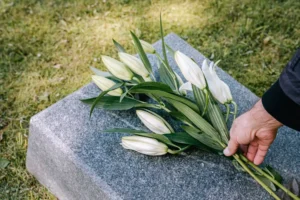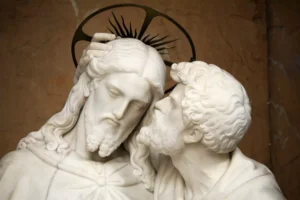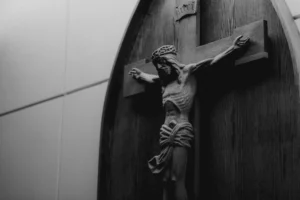I was born and raised in a Christian home, and every Easter my parents reminded me of the story of the death of Jesus. We made an Easter tree, baked “Empty Tomb” cookies and opened the colorful plastic resurrection eggs.
In middle school, I began reading books and listening to sermons about the Easter story as I started owning my faith. At that moment in U.S. Christian culture, Christian books had a particular emphasis on the crucifixion of Jesus. These books positively shaped my faith, and the cross became my abiding place and my glory, to borrow the words of the old hymn.
Yet in all my study and reading about the life and death of Jesus, the resurrection was often handled like an epilogue to the main event. I rested in the fact that my sins were covered in the blood of Christ, and the resurrection was the bow on top.
In college, I began to consider the implications of the resurrection, and saw its centrality in the Easter narrative (1 Cor. 15). I realized that my hope as a Christian isn’t only that my debts are paid and thus I won’t go to hell. Because of the resurrection, the One who paid my debts reversed the effects of the fall, and I can hope for and work toward the restoration of all creation.
N.T. Wright describes the significance of the resurrection this way:
The message of the Resurrection is that this present world matters; that the problems and pains of this present world matter; that the living God has made a decisive bridgehead into this present world with his healing and all-conquering love; and that, in the name of this strong love, all the evils, all the injustices, and all the pains of the present world must now be addressed with the news that healing, justice, and love have won the day. That’s why we pray: “Thy kingdom come, on earth as it is in heaven.” Make no bones about it: Easter Day was the first great answer to that prayer.
Because of Easter, we look to the darkness of the world and our hearts, confident that Jesus has conquered sin and made peace with God through the cross (Col. 1:19-20). But there’s more than that. We also act as agents of resurrection, confident that Jesus cares about the world and has the power to restore it. And we have the opportunity to retell this story of resurrection with our lives as we wait for Jesus to return. Here are three ways we can embody the resurrection in our daily lives.
We confidently move toward brokenness and pain.
Last year, my husband and I adopted a five-year-old dog. He had been neglected and was recovering from hip surgery after being hit by a car. When we brought him home, he wouldn’t move from his bed and would cower when we approached, afraid we would hit him.
Over the past year, we’ve loved this creature made by God, and seen the power of resurrection in this little area of our lives. As we’ve cared for our pup, fed him, walked him, played with him and showered him with affection, the brokenness of his story has been rewritten. He’s learned that he is loved, safe and cared for in our home. He no longer acts out of fear and self-preservation.
The story of my dog may seem trivial in the scheme of eternity. I would argue that it’s not trivial (for we know that God cares for animals), but it is simply a small example. In the big and small areas of our life — whether fostering a child or caring for a neglected animal — we can move toward pain, suffering, and brokenness without fear because we know that the God of the Bible has the power to reverse the story of sin.
We seek justice and peace.
As N.T. Wright notes in the above quote, the resurrection assures us that God cares not only about our eternal souls, but also the world we find ourselves living in now. He’s not a divine watchmaker standing aloof from the concerns of the world. He entered this world as a man and knew every temptation. Because of his death and resurrection, we’re confident that he will reverse the fall. As the hymn “Joy to the World” states: “He comes to make his blessings flow/ Far as the curse is found.”
Because Jesus has died, resurrected and sits at the right hand of God and will return to make all things new, we know the depths of the curse will be reversed. We can act in that power this side of the new creation, and that extends to issues like education inequality, poverty, racial injustice and drug addiction. For me, this looks like tutoring some elementary school students. The hours I spend each week reading to kids and reviewing multiplication flashcards seem meager. They’re my humble work of embodying the resurrection by working to mend the far-reaching effects of the fall. There are countless opportunities to practice resurrection through pursuing justice and peace, whether that’s volunteering at a food pantry or fostering children or counseling addicts.
We hold to hope knowing the story isn’t over.
This winter and spring, I’ve witnessed the pain and ugliness of cancer, depression, anxiety, racial injustice, education inequality, and broken families. The resurrection provides an unwavering hope that dark pain is not the end of the story. “Resurrection means that the worst thing is never the last thing,” writes Frederick Bruner. Despite the darkness and heaviness of the world, we fix our eyes on the resurrected Savior who is seated at the right hand of God the Father and who will one day return to end the story.
Wendell Berry’s poem “Manifesto: The Mad Farmer Liberation Front” has given me the lyrical language to help me respond to the resurrection. I especially love these words: “Laugh…Be joyful though you’ve considered all the facts…Practice resurrection.”
When the world is dark and the facts lure us to hopelessness and fear, we remember that our God is the one whose life and death and resurrection defied the facts. And that power that brought about the Easter story is the power at work in our lives as God’s children. Because of that, we can laugh, embrace joy, and practice resurrection.
Copyright 2017 Abigail Murrish. All rights reserved.












